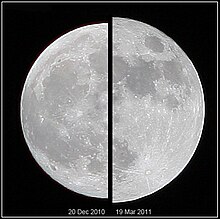A supermoon is the coincidence of a full moon or a new moon with the closest approach the Moon makes to the Earth on its elliptical orbit, resulting in the largest apparent size of the lunar disk as seen from Earth. The technical name is the perigee-syzygy of the Earth-Moon-Sun system. The term "supermoon" is not astronomical, but originated in modern astrology. The association of the Moon with both oceanic and crustal tides has led to claims that the supermoon phenomenon may be associated with increased risk of events such as earthquakes and volcanic eruptions, but the evidence of such a link is widely held to be unconvincing.
The most recent occurrence was on June 23, 2013, as the closest and largest full moon of the year and the Moon’s closest encounter with Earth for all of 2013. It will not be so close again until August 10, 2014.
Supermoons occur about once every 14 full moons in a full moon cycle.
Definition
The Moon's distance varies each month between approximately 357,000 kilometers (222,000 mi) and 406,000 km (252,000 mi) due to its elliptical orbit around the Earth (distances given are center-to-center).
According to NASA, a full moon at perigee is up to 14% larger and 30% brighter than one at its farthest point, or apogee. The full Moon occurring less than one hour away from perigee is a near-perfect coincidence that happens only every 18 years or so.
Terminology
he name SuperMoon was coined by astrologer Richard Nolle in 1979, arbitrarily defined as:
...a new or full moon which occurs with the Moon at or near (within 90% of) its closest approach to Earth in a given orbit (perigee). In short, Earth, Moon and Sun are all in a line, with Moon in its nearest approach to Earth.
The term supermoon is not used within the astronomical community, which use the term perigee-syzygy or perigee moon. Perigee is the point at which the Moon is closest in its orbit to the Earth, and syzygy is a full or new moon, when the Earth, the Moon and the Sun are aligned. Hence, a supermoon can be regarded as a combination of the two, although they do not perfectly coincide each time. On average, about once a year the moon becomes full within a few hours of perigee.











.jpg)
0 comments :
Post a Comment